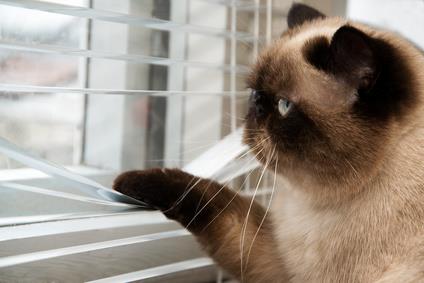Is your cat scared of people, particularly strangers? Does your cat hide under the bed whenever someone is visiting? Does he hiss at your guests or even pee all over their stuff? There are good reasons to change these behaviors. First, it might just feel wrong to leave your cat out of all the fun. Second, your cat might be anxious, stressed and unhappy. And third, your cat’s behavior can cause inconvenience for your guests or even prevent you from inviting people over.

In this article, you will learn what to do if your cat is afraid of strange people, as well as how to teach your cat that guests, workers and other visitors do not pose risk and should not cause stress and anxiety.
1. Set realistic expectations
We all want our cats to be the soul of the company, but, depending on your cat’s personality, fear level or his previous experience with humans, it might take some work to make your cat feel comfortable.
If your cat has had no experience or even had a bad experience with humans early in life, he may find it hard to trust people. That does not mean you won’t be able to change it, but the process will be slow.
Define how much you want to change your cat’s behavior, and where you are now in the process. If your cat is anxiously hiding under the bed whenever visitors arrive, success would be even if he crawled out or just became calmer.
If your cat is afraid but shows curiosity about who’s there, he might inspect the visitors and even let them pet him.
It’s best to start with small goals and set new ones each time a goal is reached. Teaching a cat to be less afraid of people is a gradual process. But don’t worry! You have plenty of time. Cats can live 20 or more years.
2. Create a space for your cat to feel safe
It’s not necessary to avoid inviting people over. When you have visitors, you should make every effort to make your cat feel comfortable.

Create at least one location in your home where your cat can have privacy. Your cat should have a space of his own not only when visitors are there, but at other times, too.
A bedroom that is not in use is a great spot for your cat. Make sure the room contains drinking water, a litter box, and a cat tree or other place where your cat can climb up and hide.
If this room has a comfortable and secure napping spot, it very well could become your cat’s favorite place all the time, not only when guests arrive.
Do not disturb your cat when he is in this room; make it your cat’s secure paradise. You can leave a small gap in the door or close the door completely when people arrive. It’s good if your cat can nap on a cat tree or a window sill there, where he is able to hear noises from the other room without stressing about possible intrusions.
There should be some sort of hiding opportunities for your cat in other rooms, too, such as cat trees, potted plants or window sills with curtains. Cats feel much safer when they are up high and unreachable to a potential threat, when they are in partial view and, most important when they have the ability to escape, if the need arises.
For example, placing a cat tree near the exit in a room where guests gather would allow your cat to observe visitors, but give him a place to run away if things get tight. A cat tree or other sitting space near the entrance of your home will encourage your cat to climb up and observe who’s coming but will make him feel secure at the same time.
It’s best to have several secure places throughout your house so your cat can easily scoot to the closest available spot, or just choose the one that suits him. You can find more information about making your home friendly to shy cats here.
IMPORTANT: If your cat’s favorite room happens to also be a guest bedroom, make sure your cat has another location he likes so he has a place to nap, eat, drink and eliminate when guests are using the other room.
3. Let things happen naturally and slowly
If you make your cat feel safe and comfortable, you should not worry about whether he comes out and interacts with people. He’s safe, and there’s nothing wrong with him napping calmly. It’s best for a fearful cat. You can learn how to comfort a fearful cat here.

Let your cat set the pace. If he is hiding, let him hide. Don’t force it. If he is staring through the doorway looking scared, you can try to encourage him to come closer using a toy, food or a soft voice.
IMPORTANT: Be calm. When you are preparing for visitors to come, and while they are there, it isn’t always easy to relax because you are setting the table, cooking dinner, preparing dessert and trying to please your in-laws. Try to be as calm as possible. Stress easily translates from owners to their pets.
Don’t exaggerate the attention you give your cat, and do not drive your guests’ attention to the cat, either. Extra attention when a cat is scared can actually “train” him to become more scared. Isn’t it ironic, don’t you think? If your cat craves attention, and being fearful provides it, he will be fearful.
Also, you shouldn’t drive visitors’ attention away from your cat. Why? Because if you tell your guests not to pay attention to the cat, there will be more tension in the room if the cat gathers his courage to appear.
If, of course, visitors are getting pushy about petting or talking to the cat and you see him displaying fear signs, you should politely tell visitors that the cat looks scared and direct their attention somewhere else.
If you know that your cat will be too scared, why not close the door to your cat’s room in advance, locking him out of all the stress? Let him get accustomed to visitor noises and move forward when you feel you both are ready.
Make your cat feel comfortable where he is. That is, after all, the most important thing for him.
4. Acclimate your cat to a human voice
Your cat must learn that people are harmless, and the best way to do that is to let the cat get to know them. Therefore, invite a few guests over often. It may sound contradictory, but the more your cat has neutral experiences with guests, the sooner he will accept them.
Don’t get me wrong, though. It’s not about hosting parties every weekend. But having a friend or two over for a cup of coffee can be invaluable to building your cat’s trust in people.
You can also leave a radio on during the day to get your cat used to hearing people’s voices. It’s good to choose a station that plays calm music (or music that fits your cat’s style preferences) and that has a DJ talking, ads running or a news broadcast.
Your cat will learn to be less troubled by noises in the house and will also become accustomed to different voices. An additional benefit is that turning on a radio in a room where your cat resides will help block out sounds your guests make.
5. Build your cat’s courage through intentional playing
Playing can be fun, but it serves many more purposes for cats, especially for their mental health. Playing is an artificial alternative to hunting, a food-gathering procedure, which is crucial to provide emotional stability. This is similar to people having less stress if they have jobs and a sufficient amount of money (even though it’s never enough).

Regular playing helps stimulate hunting behavior and boost confidence in cats. It also provides physical activity, improves health, reduces boredom and associated behavior problems, and provides several other benefits.
Try to replicate the natural hunting movements in your cat in a game resembling cat and mouse. Get a toy on a string, and try to sloooowly move it away from your cat. You can also pull it along next to him, around the corner, behind a box or move it in other ways that encourage your cat’s curiosity as if the toy were a mouse, a bird or a butterfly.
It’s important to let your cat follow the toy with his gaze, stalk it and pounce on it, and occasionally let him jump on it, chew it, sit on it or even carry it around in his mouth. Let your cat express his natural behavior by playing.
Providing solo playing toys, such as plush mice, small balls and food dispensing toys, can boost a cat’s confidence significantly. You can find other tips to build confidence in shy cats here.
